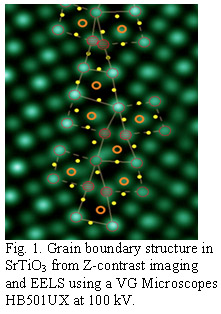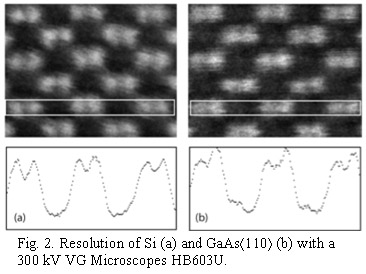Topic: Scanning Transmission Electron Microscopy: Past, Present and Future
 Scanning Transmission Electron Microscopy: Past, Present and Future
Scanning Transmission Electron Microscopy: Past, Present and Future
This lecture will trace the history of STEM from its invention by Baron Manfred von Ardenne, through the innovations by Albert Crewe, into the era of aberration-corrected high angle annular dark field (HAADF) Z-contrast imaging and electron energy loss spectroscopy (EELS) [1]. Highlights along the way include the first atomic resolution Z-contrast images of crystals [2], the explanation of their incoherent characteristics [3], and the first atomic resolution EELS [4]. The combination is unrivalled for determining atomic and electronic structure at interfaces, and made possible the first direct determination of grain boundary atomic structure, shown in Fig. 1 [5]. With the introduction of a 300 kV STEM, resolution of the dumbbell in Si and GaAs was achieved (Fig. 2). Following the successful correction of lens aberrations, Z-contrast STEM gained the record for image resolution [6], which it retains to this day [7,8], and enabled the first spectroscopic identification of a single atom inside a single atomic column in a crystal [9]. Today, with 5th order correctors, two-dimensional spectroscopic imaging is feasible. Fig. 3shows spectroscopic images that not only differentiate the elements in LaMnO3, but also show clearly the octahedral rotations of the O sublattice [10]. It is now possible to measure key parameters such as charge transfer and ferroelectric displacements across interfaces, unit cell by unit cell,to provide unique understanding of macroscopic properties.
 |
 |
1. S. J. Pennycook, Ch. 1. in Scanning Transmission Electron Microscopy, eds. S. J. Pennycook and P. D. Nellist, Springer, 2011.
2. S. J. Pennycook, L. A. Boatner, Nature336, 565 (1988).
3. S. J. Pennycook, D. E. Jesson, Phys. Rev. Lett.64, 938 (1990).
4. N. D. Browning, M. F. Chisholm, S. J. Pennycook, Nature366, 143 (1993).
5. M. M. McGibbon, et al., Science 266, 102 (1994).
6. P. D. Nellist, et al., Science 305, 1741 (2004).
7. R. Erni, et al., Phys. Rev. Lett. 102, 096101 (2009).
8. H. Sawada, et al., J. Electron Microsc. 58, 357 (2009).
9. M. Varela et al., Phys. Rev. Lett. 92, 095502 (2004).
9. S. J. Pennycook,et al., Microsc. Microanal. 16, 1420 (2010).
Research supported by the USDepartment of Energy, Office of Science, Office of Basic Energy Sciences, Materials Sciences and Engineering Division.



